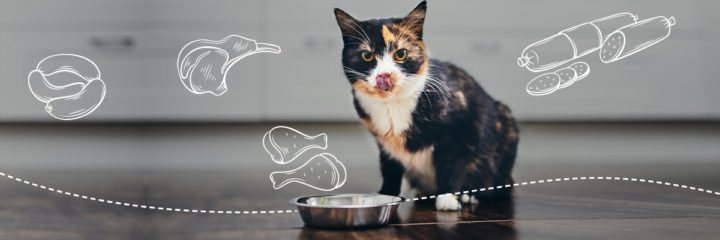
In the recent October issue of Kleintierpraxis, there was a very interesting article on the digestibility and quality of proteins in dogs, which I would like to present here because it contains a lot of factual information that is also important for understanding the gut-kidney axis in cats.
Small intestine digestibility of proteins
Not only the amount of protein consumed, but also the digestibility of the proteins and amino acids contained in the feed are essential for the supply of protein in line with requirements. The digestibility of proteins and amino acids in the small intestine plays an important role. This is also referred to as precaecal digestibility.
Protein absorption, in turn, is influenced by the type of protein source, the interaction with other feed components and also the technological feed processing. An inadequate protein supply can lead to a change in the composition of the intestinal bacteria. This can result in digestive disorders and other health problems.
With decreasing digestibility in the small intestine, more precursors of uraemic toxins are formed
If too few small intestine-digestible proteins are fed, i.e. proteins that are already digested and absorbed in the small intestine, larger amounts of proteins and amino acids enter the large intestine where they are digested and transformed by intestinal bacteria (microbiomeAll microbes on or within an animal’s tissues, for instance in the intestines (intenstinal flora = the totality of all microorganisms that colonise the intestine). It includes bacteria, protozoa, fungi and viruses....). The increased breakdown of proteins and amino acids by intestinal bacteria in the colon is associated with increased formation of precursors of uraemic toxinsToxic, nitrogen-containing urinary substances responsible for uraemia and kidney damage.... such as indole. Indole has a lasting effect on kidney health when it enters the body. The link between the precursors of uraemic toxins formed in the gut and kidney health is also known as the gut-kidney axis. In addition to indole, the breakdown of the amino acids phenylalanine, tryptophan and tyrosine also produces phenols such as p-cresol, which are absorbed by the body and, like indole, are further metabolised (in the liver) and then excreted in the urine. Phenols are known to support tumour formation in addition to kidney damage.
Small intestine digestibility important for amino acid supply
The total digestibility of proteins in the feed thus consists of the small intestine digestibility and the bacterial degradation in the large intestine. Undigested protein, which is therefore not broken down either in the small intestine or in the large intestine, leaves the animal with the faeces. Indigestible protein components are excreted together with nitrogen from bacterial protein digestion and ureaUrea is the nitrogen-containing breakdown product of protein metabolism. The nitrogen from the proteins is converted to ammonia in the liver, which is combined with carbon dioxide to form urea. This is continuously excreted via the kidneys but also via sweat. Urea is one of..., which is released from the blood into the intestine.
If high-quality protein sources of animal origin are used, it can be assumed that the supply of essential amino acids is adequate. The absorption of these essential amino acids and thus the amino acid supply takes place in the small intestine. In the large intestine, amino acids are broken down by bacteria and are then no longer available for amino acid supply. It is therefore important to ensure sufficient intake of essential amino acids in the small intestine.
Small intestine digestibility determines the quality of the feed
Ensuring a needs-based supply of essential amino acids is therefore dependent on the small intestinal digestibility of the feed protein, which determines the quality of the feed. The small intestinal digestibility of the feed protein is shaped by its protein structure, as it is important for digestibility that the digestive enzymes (from the digestive juices) can attach to the proteins. This means that proteins that are easily accessible to the digestive enzymes in the small intestine are of high quality. These include muscle meat and fresh organs. Less accessible to the digestive enzymes are, for example, horn products (claws, hooves, etc.) or feather products (e.g. feather meal).
It has also been shown in dogs that fibre components in feed, such as cellulose or various carbohydrates, lead to a reduction in protein digestion. Heat treatment of feed can have the effect of increasing digestibility. Heat treatment can alter proteins so that they are then more accessible to digestive enzymes. However, with an increase in temperature and its exposure time, the quality of the proteins can also deteriorate.
Residence time in the colon increases microbial degradation of proteins: increased formation of uraemic toxins and ammonia
In dogs, the digestibility of proteins also depends on the mental condition of the dog, the dog breed, and individual differences such as age and body size. From puppy to young dog, protein digestibility initially increases and then decreases again between 9 – 11 years of age. The influence of body size is associated with the elongated large intestine as dogs increase in body size. The lengthening of the large intestine leads to a longer retention time of food in the large intestine.
With an increase in the residence time of feed proteins in the colon, microbial digestion of proteins increases, which in turn leads to an increase in uraemic toxin precursors (such as indole) and ammonia. The majority of ammonia is excreted in the faeces. Ammonia absorbed into the organism is excreted via the kidneys in the form of urea. Urea, in turn, can pass from the blood into the intestine where it is converted into ammonia and then excreted in the faeces. Urea also provides the intestinal bacteria with a source of nitrogen for their protein formation.
Microbial degradation is influenced by feed quality
Ultimately, protein digestion is also dependent on the composition of the intestinal bacteria (microbiome). The composition of the microbiome is subject to many individual (body size, breed, weight, age, etc.) and environmental factors, but also to feeding. In feeding, the amount and type of carbohydrates and fibre components in the feed are important. However, the strongest influence on the intestinal bacteria comes from the protein content of the feed and its digestibility in the small intestine as described above. If more protein enters the large intestine, the composition of the intestinal bacteria changes in such a way that bacterial species that produce the harmful breakdown products (such as the precursors of uraemic toxins and ammonia) can proliferate. Reduced protein digestion in the small intestine can therefore be associated with health problems (gut-kidney axis).
Bibliography:
- Vierbaum, L. / Zentek, J. (2019): Ernährung von Hunden: Gutes Protein, schlechtes Protein, zu viel Protein, zu wenig Protein – Fakten und Fiktionen; In: Kleintierpraxis, 64, Oktober 2019, S.576 – 588.
- Zentek, J. (2019): Protein und Faserstoffe: Effekte auf das Mikrobiom beim Hund. Proceedings Vet Congress 14. – 16. November 2019, S. 227–229.


